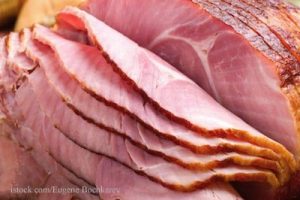 If you’re serving ham for Easter, follows these food safety tips from the U.S. Department of Agriculture (USDA). There are many different kinds of ham and each has its own set of food safety rules.
If you’re serving ham for Easter, follows these food safety tips from the U.S. Department of Agriculture (USDA). There are many different kinds of ham and each has its own set of food safety rules.
Is your ham fresh or cooked? Fresh ham is an uncured leg of pork. The word “fresh” usually appears on the label of a fresh ham to indicate that it has not been cured. These hams must be cooked to an internal temperature of 160 °F in an oven set no lower than 325 °F. Use a food thermometer to measure the temperature. After the ham is removed from the oven, let it stand for three minutes before carving.
Cooked vacuum packed, canned hams and spiral cut cooked hams can be eaten cold, according to the USDA. If you’d like to warm them, heat the slices in oven until they reach a temperature of 140 °F as measured with a food thermometer. For cooked hams that have been repackaged in any other location outside the processing plant or for leftover cooked ham, heat to 165 °F.
Cooking ham to these internal temperatures destroys foodborne pathogens such as, E. coli, Salmonella, Staphylococcus aureus and Listeria monocytogenes. It also kills parasites.
Finally, watch out for mold on country cured ham. “Most of these are harmless but some molds can produce mycotoxins. Molds grow on hams during the long curing and drying process because the high salt and low temperatures do not inhibit these robust organisms,” according to the USDA. “Do not discard the ham. Wash it with hot water and scrub off the mold with a stiff vegetable brush.




